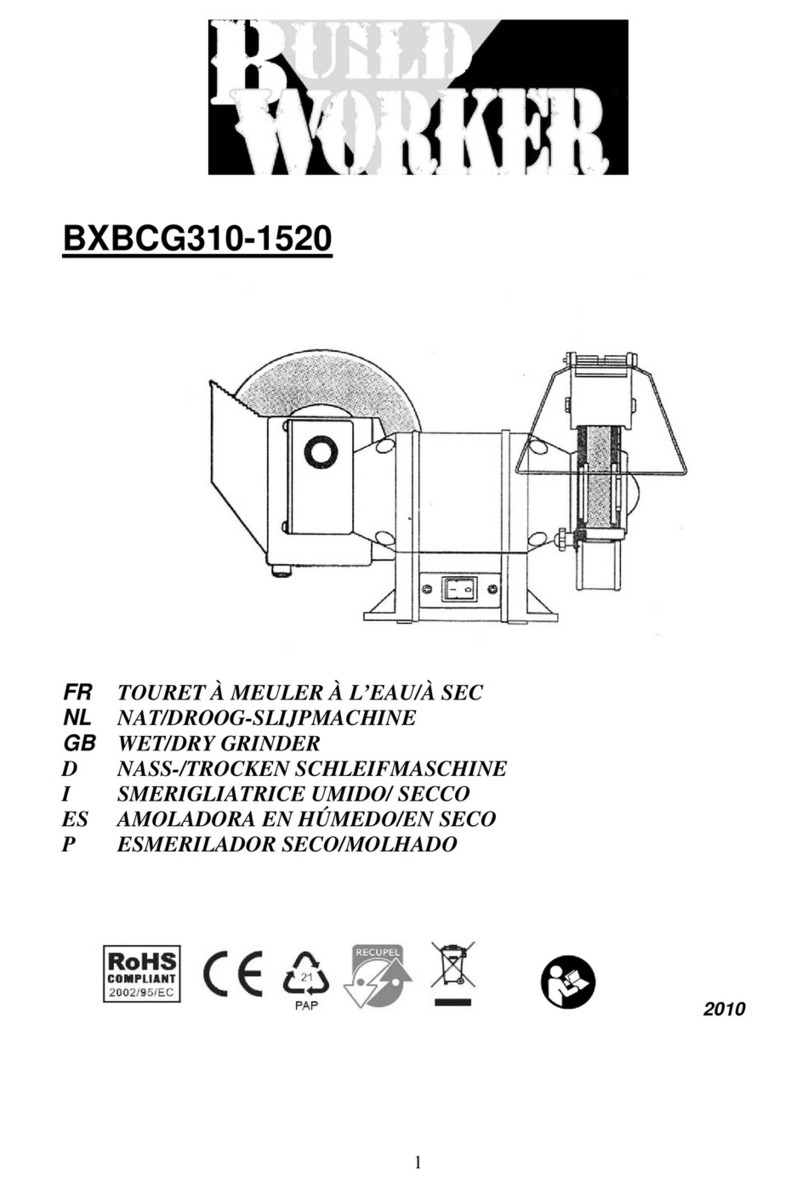
GB
COMBINATION BENCH
GRINDER
WARNING
Read this manual carefully before using the
machine, for your own safety.
SAFETY INSTRUCTIONS
When using the machine, always observe
the enclosed safety instructions as well as
the additional safety instructions.
The following symbols are used throughout
this manual:
Denotes risk of personal injury
or damage to the tool.
ADDITIONAL SAFETY INSTRUCTIONS FOR
BENCH GRINDERS
n Always wear safety goggles while grinding.
n Keep children out of the work area.
n Never operate the grinder without the wheel guard
in place.
n Always securely fix the workpiece support.
n The distance between the spark guard and the
grinding wheel must not exceed 2 mm.
n The distance between the workpiece support and
the grinding wheel must not exceed 2 mm.
n Never use damaged grinding wheels.
n Replace the grinding wheel when it has worn by
more than approx. 40 mm.
ELECTRICAL SAFETY
Always check that the power
supply corresponds to the
voltage on the rating plate.
DESCRIPTION
Your combination bench grinder has been
designed for sharpening metal and wooden
tools, including knives, chisels and other
cutting tools.
1 On/off switch
2 Workpiece support grinding wheel
3 Grinding wheel
4 Transparant screen
5 Spark guard
6 Grinding belt
7 Workpiece support grinding belt
8 Mounting hole
Mounting the machine
The machine must be screwed to a workbench.
n Mark the position of the mounting holes (8)
on the workbench.
n Drill holes at each of the marked
positions, adjusting the diameter and
depth of the holes to the screws used.
n Place the machine on the workbench and
insert the screws into the mounting holes.
n Firmly tighten the screws.
Replacing the grinding wheel
n Remove the wheel guard (9).
n Loosen the nut (10).
n Remove the outer flange (11) and the old
grinding wheel (3).
n Clean the flanges (11 & 12).
n Place a new grinding wheel.
n Place the outer flange against the grinding
wheel and place the nut onto the spindle.
Securely tighten the nut.
n Replace the wheel guard.
Always unplug the tool before
replacing a grinding wheel.
Never use a cracked grinding
wheel. Immediately replace a
cracked grinding wheel.
A cracked grinding wheel may
break into pieces when used
and cause accidents.
Replacing the grinding belt
n Remove the belt guard (13).
n Loosen the locking knob (14).
n Using the lip (16) press the spring (17) to
release the tension on the grinding belt (6).
Tighten the locking knob.
n Remove the old grinding belt.
n Successively place the new grinding belt over
the drive roll (18) and the upper roll (19).
n Loosen the locking knob and push the upper roll
as much to the rear to tension the grinding belt.
n Tighten the locking knob. If necessary adjust the
position of the grinding belt by turning the set screw
(15) in or out.
n Replace the belt guard.
Always unplug the tool before
replacing a grinding belt.
Never use a torn grinding belt.
Immediately replace a torn
grinding belt. A torn grinding
belt may burst when used and
cause accidents.
Mounting and adjusting the spark guard
You must regularly adjust the spark guard in order
to compensate the wear of the grinding wheel.
n Mount the spark guard (5) to the wheel guard (9)
as shown.
n Adjust the distance between the spark guard
and the grinding wheel (3) to the smallest possible
value, with a maximum of 2 mm.
n Tighten the spark guard screw.
n Slide the screen (4) to the front.
n Tighten the nut (20).




























